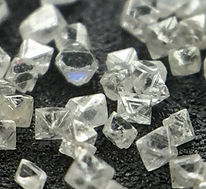About Diamonds
Diamond is nearly pure carbon. It forms with the cubic crystal structure and forms deep in the earth where the heat and pressure are intense enough to crystalize carbon into diamond, about 150 miles below the surface of the earth. Volcanic activity brings them to the surface where they can be found. In optimal conditions, a diamond will form an octahedral crystal.
Most diamonds have trace amounts of nitrogen. These are known as Type 1 diamonds. Nitrogen can cause the diamond to have a brownish or yellowish hue. The whitest (most colorless) diamonds have no nitrogen. These are called Type 2 diamonds. Over 90% of all natural diamonds found are Type 1 diamonds and the rest being Type 2.
Diamonds are found in many places around the world with Africa, Russia, Canada and Australia being major sources.

Lab Created Diamonds
Lab Created diamonds are also called Lab Grown but both refer to the same thing: Man Made Diamonds.
These are diamonds in every sense of the word. They have the same chemical composition and physical properties, except they are produced in a factory instead of being mined from the ground. Most lab created diamonds in the market today are of very fine quality and cost a fraction of a natural earth mined diamond of the same quality.
It can be difficult to tell the difference between the lab created diamonds and the natural earth mined diamonds, but there are instruments that can help.
To date, all man made diamonds are type 2 diamonds. Most of the instruments on the market today detect type 2 diamonds. In most cases this may suffice for most appraisers but they are not 100% fool proof and only testing in a professional gem lab can offer complete certainty.




